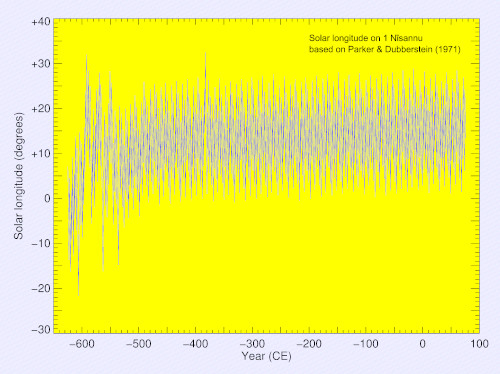in the Julian calendar
Elamite
| Nr. | Month names | Approximate equivalent
in the Julian calendar |
|||||||
| Babylonian | Hebrew | Old Persian | Achaemenian
Elamite |
Elamite | Macedonian(#) | ||||
| earlier correlation | later correlation | ||||||||
| I | Nīsannu | Nīsān | Ādukanaiša | Hadukannaš | Zikli | Artemisios | Xanthikos | March-April-May | |
| II | Ayyāru | Iyyār | Θūravāhara | Turmar | Zarpakim | Daisios | Artemisios | April-May-June | |
| III | Sīmannu | Sīwān | Θāigraciš | Sākurriziš | Hadar | Panemos | Daisios | May-June-July | |
| IV | Duʾūzu | Tammūz | Garmapada | Karmabataš | Hallime | Loös | Panemos | June-July-August | |
| V | Ābu | Āb | ??? | Turnabaziš | Zillatam | Gorpiaios | Loös | July-August-September | |
| VI | Ulūlū | Elūl | ??? | Karbašiyaš | Belilit | Hyperberetaios | Gorpiaios | August-September-October | |
| VII | Tašrītu | Tišrī | Bāgayādiš | Bakeyatiš | Manšarki | Dios | Hyperberetaios | September-October-November | |
| VIII | Araḫsamna | Marḥešwān | *Vrkazana | Markašanaš | Lankelli | Apellaios | Dios | October-November-December | |
| IX | Kisilīmu | Kislēw | Āçiyādiya | Hašiyatiš | Šibari | Audynaios | Apellaios | November-December-January | |
| X | Ṭebētu | Ṭēbēt | Anāmaka | Hanamakaš | Šermi | Peritios | Audynaios | December-January-February | |
| XI | Šabāṭu | Šebāṭ | *Θwayauvā | Samiyamaš | Kutmama | Dystros | Peritios | January-February-March | |
| XII | Addāru | Adēr | Viyax(a)na | Miyakannaš | Aššetukpi | Xanthikos | Dystros | February-March-April | |
# epigraphical and numismatical sources indicate that, between 31 CE and 46/47 CE, the
correlation
of the Macedonian months with the Babylonian months underwent a shift of one month
In order to keep the Babylonian calendar aligned with the seasons various intercalation schemes were employed.

According to the calendrical tables of Parker & Dubberstein (1971), the date of the Babylonian New Year was closely linked with that of the spring equinox.
Initially, during the Neo-Babylonian Period, the Babylonian New Year tended to fall slightly before the spring equinox but after the Achaemenids gained control of Mesopotamia and introduced the 19-year intercalation cycle the Babylonian New Year dates gradually shifted until they fell on or after that of the spring equinox.